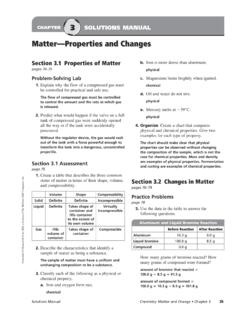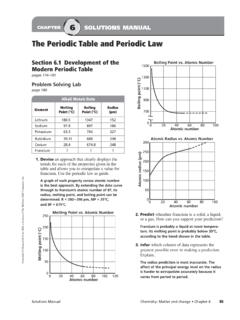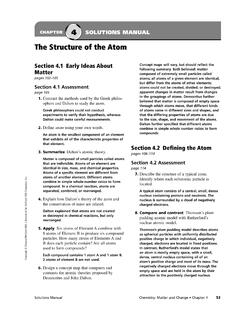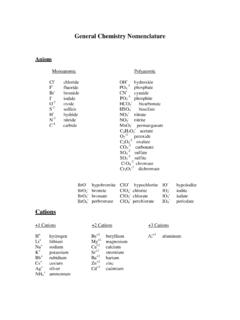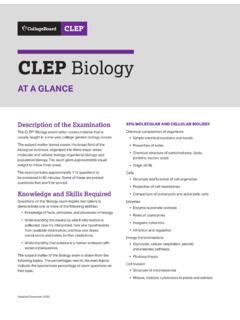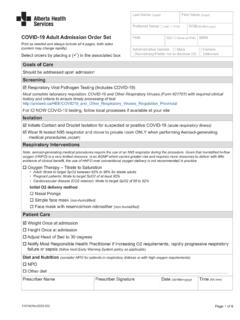Transcription of Covalent BondingCovalent Bonding - Weebly
1 Copyright Glencoe/McGraw-Hill, a division of The McGraw-Hill Companies, MANUALCHAPTER8 Covalent BondingCovalent BondingSolutions Manual Chemistry: Matter and Change Chapter 8 121 Section The Covalent Bondpages 240 247 Practice Problemspage 244 Draw the Lewis structure for each molecule. 1. PH3H HHH HHP P 2. H2SH H H H S S 3. HClH H Cl Cl 4. CCl4Cl Cl Cl C C Cl Cl Cl Cl Cl 5. SiH4 HHHH HHHSiSi H 6. Challenge Draw a generic Lewis structure for a molecule formed between atoms of group 1 and group 16 1 and 16 to represent atoms of groups 1 and 16, respectively, the generic structure is: Section Assessmentpage 247 7.
2 Identify the type of atom that generally forms Covalent bonds. The majority of Covalent bonds form between nonmetallic elements. 8. Describe how the octet rule applies to Covalent share valence electrons; the shared electrons complete the octet of each atom. 9. Illustrate the formation of single, double, and triple Covalent bonds using Lewis structures. Student Lewis structures should show the sharing of a single pair of electrons, two pairs of electrons, and three pairs of electrons, respectively, for single, double, and triple Covalent bonds. 10. Compare and contrast ionic bonds and cova-lent electrons are involved in both types of bonds.
3 In Covalent bonds, atoms share electrons, whereas is ionic bonds, electrons are transferred between atoms. 11. Contrast sigma bonds and pi bonds. A sigma bond is a single Covalent bond formed from the direct overlap of orbitals. A pi bond is the parallel overlap of p orbitals. 12. Apply Create a graph using the bond- dissociation energy data in Table and the bond-length data in Table Describe the relationship between bond length and bond-dissociation graphs should show that as bond length decreases the bond dissociation energy DissociationEnergy (kJ/mol)02004006008001000 Covalent Bond Length (10 10m) Covalent Bond Length vs.
4 Bond Dissociation EnergyCopyright Glencoe/McGraw-Hill, a division of The McGraw-Hill Companies, Chemistry: Matter and Change Chapter 8 Solutions Manual 13. Predict the relative bond energies needed to break the bonds in the structures H C C H C H: less energy than C Cb. HHHHCC C H: less energy than C CSection Naming Moleculespages 248 252 Practice Problemspages 249 251 Name each of the binary Covalent compounds listed below. 14. CO2carbon dioxide 15. SO2sulfur dioxide 16. NF3nitrogen trifluoride 17. CCl4carbon tetrachloride 18. Challenge What is the formula for diarsenic trioxide?A r 2 O 3 Name the following acids.
5 Assume each compound is dissolved in water. 19. HIhydroiodic acid 20. HClO3chloric acid 21. HClO2chlorous acid 22. H2SO4sulfuric acid 23. H2 Shydrosulfuric acid 24. Challenge What is the formula for periodic acid?HIO4 Give the formula for each compound. 25. silver chlorideAgCl 26. dihydrogen oxideH2O 27. chlorine trifluorideClF3 28. diphosphorus trioxideP2O3 29. disulfur decafluorideS2F10 30. Challenge What is the formula for carbonic acid?H2CO3 Section Assessmentpage 252 31. Summarize the rules for naming binary molecular the first element in the formula first. Name the second element using its root plus the suffix ide. Add prefixes to indicate the number of atoms of each element present.
6 32. Define a binary molecular molecule composed of only two nonmetal elements 33. Describe the difference between a binary acid and an binary acid contains hydrogen and one other element. An oxyacid contains hydrogen, another element, and MANUALCHAPTER8 Copyright Glencoe/McGraw-Hill, a division of The McGraw-Hill Companies, Manual Chemistry: Matter and Change Chapter 8 123 34. Apply Using the system of rules for naming binary molecular compounds, describe how you would name the molecule are two atoms of nitrogen; use the prefix di with the name nitrogen. There are four atoms of oxygen, so use the prefix tetra the root of oxygen the ending ide.
7 The name is dinitrogen tetroxide. 35. Apply Write the molecular formula for each of these compounds:, iodic acid, disulfur trioxide, dinitrogen monoxide, hydrofluoric acid. HIO3, S2O3, N2O, HF 36. State the molecular formula for each compound listed dinitrogen trioxideN2O3 b. nitrogen monoxideNOc. hydrochloric acidHCl d. chloric acidHClO3e. sulfuric acidH2SO4f. sulfurous acidH2SO3 Section molecular Structurespages 253 260 Practice Problemspages 255 260 37. Draw the Lewis structure for H HB 38. Challenge A nitrogen trifluoride molecule contains numerous lone pairs. Draw its Lewis structure. N F F F 39.
8 Draw the Lewis structure for ethylene, C2H4. CCHHHH 40. Challenge A molecule of carbon disulfide contains both lone pairs and multiple- Covalent bonds. Draw its Lewis C S 41. Draw the Lewis structure for ethylene, NH4+ ion. 1+NHHHH 42. Challenge The ClO4 ion contains numerous lone pairs. Draw its Lewis structure. Cl O O 1O O Draw the Lewis resonance structures for the following molecules. 43. NO2 NOO1 NO1 O 44. SO2 SOSOOOSOLUTIONS MANUALCHAPTER8 Copyright Glencoe/McGraw-Hill, a division of The McGraw-Hill Companies, Chemistry: Matter and Change Chapter 8 Solutions Manual 45. O3 OOOOOO 46. Challenge Draw the Lewis resonance structure for the ion SO32.
9 2 SOOOOOOOOO2 S2 SDraw the expanded octet Lewis structure of each molecule. 47. ClF3 ClFFF 48. PCl5 ClClClClPCl 49. Challenge Draw the Lewis structure for the molecule formed when six fluorine atoms and one sulfur atom bond Assessmentpage 260 50. Describe the information contained in a structural of atoms, number of atoms, and a rough approximation of the molecular shape 51. State the steps used to draw Lewis ) determine central atom and terminal atoms, 2) determine number of Bonding electrons, 3) determine Bonding pairs, 4) connect terminal atoms to the central atom with single bonds, 5) determine remaining number of Bonding pairs, 6) apply octet rule and form double or triple bonds if needed 52.
10 Summarize exceptions to the octet rule by correctly pairing these molecules and phrases: odd number of valence electrons, PCl5, ClO2, BH3, expanded octet, less than an octet. expanded octet, PCl5; odd number of valence electrons, ClO2; less than an octet, BH3 53. Evaluate A classmate states that a binary compound having only sigma bonds displays resonance. Could the classmate s statement be true?No, a molecule or polyatomic ion must have both a single bond and a double bond in order to display resonance. Only single bonds can be sigma bonds. 54. Draw the resonance structures for the dinitrogen oxide (N2O) N O or N N O 55. Draw the Lewis structure for CN , SiF4, HCO3 , and AsF6.
